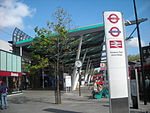Finsbury Park station
1861 establishments in EnglandDfT Category C2 stationsFormer Great Northern, Piccadilly and Brompton Railway stationsFormer Great Northern Railway stationsFormer Great Northern and City Railway stations ... and 17 more
London Underground Night Tube stationsLondon stations without latest usage statistics 1415London stations without latest usage statistics 1516Piccadilly line stationsRail transport stations in London fare zone 2Railway stations in Great Britain closed in 1964Railway stations in Great Britain opened in 1861Railway stations in Great Britain opened in 1904Railway stations in Great Britain opened in 1906Railway stations in Great Britain opened in 1965Railway stations in the London Borough of IslingtonRailway stations located underground in the United KingdomThameslink railway stationsTube stations in the London Borough of IslingtonUnopened Northern Heights extension stationsUse British English from August 2012Victoria line stations

Finsbury Park is an intermodal interchange station in north London. It serves a number of National Rail, London Underground and bus services. The station is the third busiest Underground station outside Zone 1, with over 33 million passengers using the station in 2019.
Excerpt from the Wikipedia article Finsbury Park station (License: CC BY-SA 3.0, Authors, Images).Finsbury Park station
Station Place, London Finsbury Park (London Borough of Islington)
Geographical coordinates (GPS) Address External links Nearby Places Show on map
Geographical coordinates (GPS)
| Latitude | Longitude |
|---|---|
| N 51.564653 ° | E -0.106366 ° |
Address
Finsbury Park Station
Station Place
N4 2DH London, Finsbury Park (London Borough of Islington)
England, United Kingdom
Open on Google Maps







